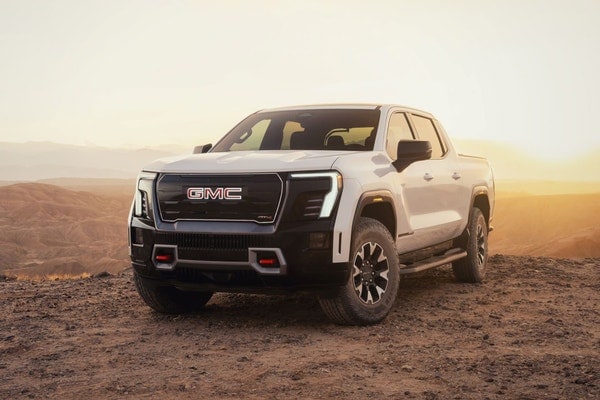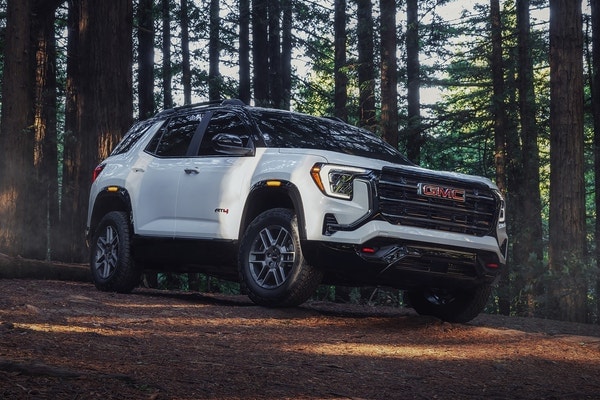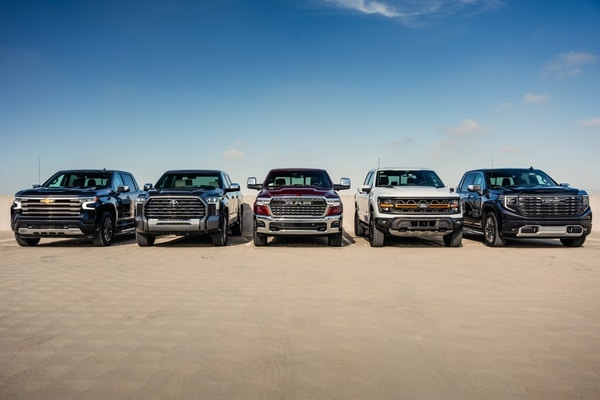2009 GMC Sierra 1500 Hybrid Review
Price Estimate: $6,330 - $9,789
 View 48 more photos
View 48 more photos View 48 more photos
View 48 more photos View 48 more photos
View 48 more photos View 48 more photos
View 48 more photos View 48 more photos
View 48 more photos+44
GMC Sierra 1500 Hybrid model years
Edmunds' Expert Review
by the Edmunds Experts
Pros
- Superior city gas mileage for a big truck, can accelerate to 29 mph solely on electric power.
Cons
- Questionable value, only one body style, quirky power delivery, upscale dashboard layout unavailable.
What’s new
The 2009 GMC Sierra 1500 Hybrid makes its debut as the first full-size pickup truck with true dual-mode hybrid technology.
Edmunds says
If you like the sound of dual-mode hybrid technology in a full-size pickup, the 2009 GMC Sierra 1500 Hybrid crew cab and its Chevrolet Silverado twin are the only games in town. However, we question the value of these trucks relative to their conventionally powered brethren.
For sale near Topeka, KS
2 listings
- 194,049 miles
- No accidents, 2 owners, personal use only
- 5'9” bed, 6l, 8cyl
- Dynamite Deals (286 mi away)
- Bluetooth
- Power Driver Seat
- Tire Pressure Warnin...
- Multi-Zone Climate C...
- Auto Climate Control
Close
Located in Arnold, MO
AutoCheck Vehicle History Summary
Accident Free Vehicle: Yes
Personal Use Only: Yes
History Provider: AutoCheck
Title Details: Clean Title
Salvage Vehicle: No
Frame Damage: No
Theft History: No
Lemon Status: No
Free History Report: No
Features and Specs:
21 Combined MPG (21 City/22 Highway)
Listing Information:
VIN: 2GTFC135291120270
Stock: 120270
Certified Pre-Owned: No
Listed since: 05-08-2025- 274,000 miles
- 1 accident, 8 owners, personal use only
- 5'9” bed, 6l, 8cyl
- T&L Auto Sales (316 mi away)
- AWD/4WD
- Bluetooth
- Navigation
- Leather Seats
- Sunroof/Moonroof
Close
Located in Sioux Falls, SD
NEW HYBRID BATTERY, LEATHER INTERIOR, POWER DRIVER & PASSENGER SEATS, NAVIGATION, TONNEAU COVER, SPRAY IN BED LINER, TOW PACKAGE
AutoCheck Vehicle History Summary
Accident Free Vehicle: No
Personal Use Only: Yes
History Provider: AutoCheck
Title Details: Clean Title
Salvage Vehicle: No
Frame Damage: No
Theft History: No
Lemon Status: No
Free History Report: No
Features and Specs:
20 Combined MPG (20 City/20 Highway)
Listing Information:
VIN: 2GTFK135X91107298
Stock: 107298
Certified Pre-Owned: No
Listed since: 04-17-2024
Vehicle overview
The 2009 GMC Sierra 1500 Hybrid crew-cab pickup strikes us as an answer to a question that not many people were asking. Thanks to the same dual-mode hybrid technology employed in GM's full-size SUVs, the Sierra Hybrid 2WD nets a remarkable 21 mpg in the city and 22 mpg on the highway, and it can even accelerate -- albeit very slowly -- up to 29 mph using only its battery-powered electric motors. However, it's only offered in the crew-cab body style, it costs thousands more than a comparably equipped Sierra 1500 SLE crew cab, and GM's upscale full-size truck/SUV dashboard layout is unavailable despite the Hybrid's elevated $38,000 base price. Moreover, although the 332-horsepower, 6.0-liter hybrid power plant sounds imposing, its somewhat odd power delivery and decent but unremarkable towing capacity may further limit its appeal. As an exercise in environmental awareness, the Sierra Hybrid is admirable; as a consumer product, we're not sure it makes much sense.
Technologically, the Sierra Hybrid is a marvel and much more advanced than the original, mild-hybrid Sierra produced from 2005-'07. A complex four-speed electrically variable transmission -- essentially a combination of a conventional automatic transmission and a continuously variable one (CVT) -- works in tandem with a 6.0-liter V8 and two 60-kilowatt electric motors to propel the Sierra's considerable mass. A 300-volt nickel-metal hydride battery pack (located underneath the rear bench seat) provides the juice for the electric motors, and a regenerative braking system recharges that battery pack during deceleration.
While official output is 332 hp, GM claims that the electric motors bump combined output to a healthy 379 hp. On top of all that, the V8 is endowed with cylinder-deactivation technology, enabling it to run in four-cylinder mode under many circumstances. The Sierra Hybrid's "dual-mode" nature means that the gas and electric motors can work either separately or in concert -- the gas engine shuts off at low speeds when it's not needed, and it seamlessly comes online when acceleration or higher-speed operation is required. Overall, you're looking at an approximate 40-percent improvement in city fuel economy compared to a regular Sierra, though the improvement in highway mileage is much less dramatic. In fact, the economy-minded Sierra XFE is rated at 21 highway mpg, just 1 mpg shy of the Hybrid's 22 mpg highway rating. Meanwhile, the regular Sierra with the 5.3-liter V8 yields 20 highway mpg.
The Sierra Hybrid's technology is highly impressive for a vehicle that begins life as a simple work truck. Nonetheless, the bottom line is bemusing. A $2,200 federal tax credit helps considerably, yet the base Sierra Hybrid 1HY still costs $3,000-$4,000 more than a comparably equipped Sierra 1500 SLE crew cab with the 4.8-liter V8 engine, and the gap widens further if you delete extraneous Hybrid standard features like a tonneau cover and automatic climate control.
In fairness, the Sierra 1500 Hybrid should have significant appeal for certain buyers. Green-oriented businesses might like the truck's reduced carbon footprint and public-image-boosting "Hybrid" badges, and contractors who plan to do a lot of city driving might even earn back the initial price premium before too many years have gone by. For most people, though, the 2009 GMC Sierra 1500 Hybrid seems destined to remain an overpriced curiosity.
Performance & mpg
The Sierra 1500 Hybrid is available in either two- or four-wheel drive. It's powered by a 6.0-liter V8 with cylinder-deactivation technology teamed with two 60-kilowatt electric motors, which are in turn supplied by a nickel-metal hydride battery pack. Official output is 332 hp, but GM suggests a total output of 379 hp with the electric motors taken into account. The electrically variable transmission does a fair impression of a conventional four-speed automatic, but it's actually a complex cross between a regular automatic and a CVT. The Hybrid's maximum tow rating is 6,100 pounds, which is roughly on par with the 4.8-liter and 5.3-liter V8s, but well below the 10,600-pound maximum for the big-daddy 6.2-liter V8.
EPA fuel economy estimates are 21 mpg city/22 mpg highway with 2WD and 20/20 with 4WD. The city is where the Hybrid shines -- most full-size trucks are in the 14-15-mpg range.
Safety
The 2009 GMC Sierra 1500 Hybrid comes standard with stability control, antilock disc brakes and full-length side curtain airbags. OnStar is also included.
The Sierra Hybrid has not been crash-tested, but the regular Silverado's results should be applicable. In government crash tests, the 2009 GMC Sierra 1500 earned top five-star ratings for its protection of all occupants in head-on and side impact collisions. Oddly, the Insurance Institute for Highway Safety had quite different results -- the Sierra earned the top "Good" rating in frontal-offset crash testing, but the worst rating of "Poor" in side impacts because it lacks side airbags that protect front occupants' torsos.
Driving
The 2009 GMC Sierra 1500 Hybrid doesn't feel as powerful as 6.0 liters and a claimed 379 hp would suggest. The main culprit is the powertrain's complexity: Floor the Hybrid from a stop and there's a pregnant pause as the truck creeps forward in electric mode, then hurtles away once the gas engine comes online. The transmission is quirky, too -- under the same conditions, it will whisk the engine up to 4,500 rpm, pause noticeably to change ratios and then settle down around 4,000 rpm, from which point it acts much like a CVT. It's undeniably neat to take a full-size pickup from zero to 29 mph solely under electric power, but the eccentric power delivery and unremarkable towing capacity render the cheaper 4.8-liter and 5.3-liter V8s wholly viable alternatives, particularly if fuel economy is not a top priority. The electric power steering system is characteristically light and numb but adequately precise, while brake feel is impressively organic for a regenerative system.
Interior
Other than a few hybrid-specific gauges behind the steering wheel, the 2009 GMC Sierra 1500 Hybrid's cabin is pure work truck. The plastics are a uniformly somber black, and the functional but rudimentary switchgear doesn't exactly exude class. That's not a problem for a regular Sierra, but considering the Hybrid's elevated price, it'd be nice to have the prettified dash at least as a stand-alone option. The rear seat is roomy and comfortable, as it should be in a crew cab, though the seatback angle is a bit stern.
2009 GMC Sierra 1500 Hybrid models
The 2009 GMC Sierra 1500 Hybrid is a full-size crew-cab pickup available in either 3HA or 3HB trim. The base 3HA comes standard with 18-inch alloy wheels, towing preparation, a soft bed tonneau cover, a 40/20/40-split front bench, keyless entry, full power accessories, dual-zone automatic climate control, a leather-wrapped steering wheel with auxiliary audio controls, cruise control, OnStar, Bluetooth and a six-speaker CD/MP3 stereo with satellite radio. The 3HB ups the luxury quotient in a serious way with foglamps, heated exterior mirrors with integrated turn signals, rear parking sensors, a hard bed tonneau cover, a navigation system with real-time traffic updates, an upgraded Bose audio system, rear audio controls, a floor-mounted center console, an auto-dimming rearview mirror, power-adjustable pedals, leather upholstery and power front bucket seats.
A power driver seat is a stand-alone option for the base 3HA. Other options include remote start, a power sunroof (3HB only), a hybrid decal package and an engine block heater.

2026 GMC Sierra EV AT4 First Drive: Taking the Electric Pickup Off-Road

2026 GMC Terrain First Drive: Stretching Upmarket

Ford F-150 vs. Chevy Silverado vs. GMC Sierra vs. Ram 1500 vs. Toyota Tundra: Every Full-Size Truck Compared

GMC Sierra EV Adds Less-Expensive AT4 and Elevation Trims for 2026
Compare 2009 GMC Sierra 1500 Hybrid trim levels
Helpful trims summary and side-by-side comparison chart
Cost to Drive
Monthly estimates based on costs in Kansas
$169/mo for Sierra 1500 Hybrid Base
Sierra 1500 Hybrid Base
vs
$212/mo
Avg. Large Truck
GMC Sierra 1500 Hybrid Owner Reviews
Most Helpful Owner Reviews
Trending topics
Welcome Addition Update
4.88 out of 5 starsCali, 08/29/2009
2009 GMC Sierra 1500 Hybrid 4dr Crew Cab SB w/3HA (6.0L 8cyl gas/electric hybrid 4A)
Just a quick update on my previous review. First, my problems with dis- engaging brakes and abrupt transmission shifts have been solved. The dealer where my Sierra Hybrid was sourced neglected to update my software. Updating software fixed the brake problem and a faulty transmission pump fixed the gear shifting problem. My Sierra now drives just like a standard Sierra and I'm a huge … fan and I can confidently say that I would absolutely recommend this truck.
I Welcome Addition
4.13 out of 5 starsCali, 08/14/2009
2009 GMC Sierra 1500 Hybrid 4dr Crew Cab SB w/3HA (6.0L 8cyl gas/electric hybrid 4A)
I recently purchased a 2009 Sierra Hybrid, 2WD truck. My initial impression is that this is a great vehicle. I have all of the standard features of a Sierra with gas mileage averaging 21 MPG combined City/Highway. Outstanding! Contrary to Expert reviews, I would not agree with assessments that transitions shifts between electric and gas as seamless. On the contrary, these … transitions can be felt-- abruptly in some instances. I also have concerns regarding the transition between regenerative and hydraulic brakes. In some instances, my brakes have actually disengaged momentarily making me feel as though I might roll into the vehicle in front of me. A very uncomfortable feeling.
Great Truck
4.13 out of 5 starsMelvin Brandstetter, 01/23/2010
2009 GMC Sierra 1500 Hybrid 4dr Crew Cab SB w/3HA (6.0L 8cyl gas/electric hybrid 4A)
Cruise control doesn't work well if at all down hill. Tried Asking GM customer service VIA the phone about it. But the problem with this is, they just do not know and try to read the owners manual to you, Their is no information on how it works or even if it works in the owners manual. They are providing this support from their centers around World.. (One insisted Hydromantic meant … Hybrid transmission). My Dodge manual - states clearly + or - 2 MPH down hill. I took it in to my dealer and said it doesnt hold on any hill I drive (unlike all my other vehicles. They said they can't fix it as their GM Tec paper states it may work or it may not, depending on the hill, and to down shift.
2009 Sierra 1500 Hybrid Highlights
| Base MSRP Excludes Destination Fee | $38,390 |
|---|---|
| Engine Type | Hybrid |
| Combined MPG | 21 MPG |
| Cost to Drive | $169/month |
| Seating | 6 seats |
rear wheel drive | |
| Max Towing Capacity | 6,100 lbs. |
| Warranty | 3 years / 36,000 miles |
Safety
Key safety features on the Sierra 1500 Hybrid include:
- Alarm
- Tire Pressure Warning
- Stability Control
- Post-collision safety system
NHTSA Overall Rating
The National Highway Transportation Safety Administration offers independent analysis.
- Frontal Barrier Crash RatingOverallNot RatedDriver5 / 5Passenger5 / 5
- Side Crash RatingOverallNot Rated
- Side Barrier RatingOverallNot RatedDriver5 / 5Passenger5 / 5
- Combined Side Barrier & Pole RatingsFront SeatNot RatedBack SeatNot Rated
- RolloverRollover4 / 5Dynamic Test ResultNo TipRisk Of RolloverNot Rated
IIHS Rating
The Insurance Institute of Highway Safety uses extensive crash tests to determine car safety.
- Small Overlap Front Driver-Side TestNot Tested
- Small Overlap Front Passenger-Side TestNot Tested
- Moderate Overlap Front Test – OriginalNot Tested
- Moderate Overlap Front Test – UpdatedNot Tested
- Side Impact Test – OriginalNot Tested
- Side Impact Test – UpdatedNot Tested
- Roof Strength TestNot Tested
- Rear Crash Protection / Head RestraintAcceptable
Related Used 2009 GMC Sierra 1500 Hybrid info
Vehicle reviews of used models
- Land Rover Range Rover Velar 2021 Review
- Audi E Tron Sportback 2021 Review
- Mercedes Benz Cla Class 2021 Review
- Buick Enclave 2021 Review
- Hyundai Ioniq Plug In Hybrid 2021 Review
Shop used vehicles in your area
- Used GMC Sierra 1500 Hybrid 2010
- Used GMC Sierra 1500 Hybrid 2011
- Used GMC Sierra 1500 Hybrid 2012
- Used GMC Sierra 1500 Hybrid 2013
Popular new car reviews and ratings
- 2026 Buick Enclave News
- 2025 CR-V e:FCEV
- 2025 Porsche 911
- 2025 BMW M5
- New Chevrolet C/K 1500 Series
- 2024 Grand Cherokee 4xe
- Ford Fusion Used Car
- New Nissan Truck
- 2026 Nissan Frontier News
- 2026 GMC Canyon News
Research other models of GMC
- New GMC Sierra 2500HD
- 2025 GMC Sierra 2500HD
- GMC Sierra 1500 2024
- 2025 GMC HUMMER EV SUV
- 2025 Sierra 1500
- 2024 Sierra 1500
- 2024 GMC HUMMER EV
- 2025 GMC Sierra 3500HD
- GMC Sierra 3500HD 2024
- New GMC Yukon XL
Research similar vehicles
Other models
- Used Mclaren 765LT in Mankato, MN 2021
- Used Mitsubishi 3000GT in Milford, MA 1999
- Used Buick Lucerne in Ooltewah, TN 2011
- Used Tesla Model-Y in Hurst, TX 2026
- Used Smart Fortwo in Decatur, AL 2018
- Used Toyota Corolla-Cross in Watertown, CT 2025
- Used Kia Forte in Saint Paul, MN 2024
- Used Audi Q5-Sportback in Encino, CA 2025
- Used Lincoln Mark-Viii in Reisterstown, MD 1998
- Used Jeep Gladiator in Palatine, IL 2025

